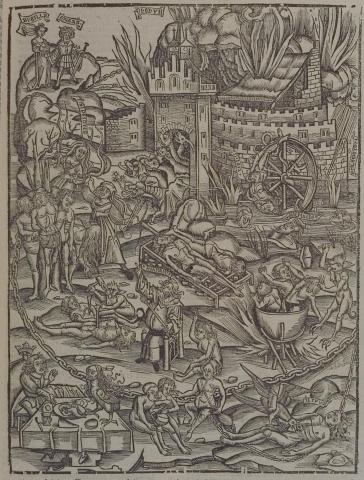Aeneas and the Sibyl pass the city of Tartarus, where the damned suffer their punishments. In the text, the tortured souls are enclosed in the city walls, and the Sibyl explains the various punishments; for the sake of better illustration, however, the tortures are displayed in front of the city, with Tartarus in the background. The city itself is, as Vergil describes it, surrounded by three walls and engulfed in flames (548-50). The Phlegethon runs next to the city (551). Near the center of the image, Rhadamanthus, the judge of the guilty, points toward Tisiphone, one of the Furies, whose job it is to throw the condemned shades into Tartarus (554-6). She stands directly below Aeneas and the Sibyl, and holds a pair of snakes in her hand. One of her sisters stands next to her holding knitting needles in one hand and snakes in the other (572). She appears to be using her snakes to whip three men tied to a small tree. A figure, either another condemned person or a third Fury, stands bent over next to the three men. Within the large gate of Tartarus sits the many-headed Hydra, guarding the entrance to the city (574-7). To the right of the Hydra, just outside the walls, Ixion is stretched out on his wheel (601). Salmoneus, who is punished for mimicking Jove, is seen floating in the Phlegethon, since Vergil does not specify his punishment (585-94).
In the lower right corner, Tityos, son of the Earth has his liver and entrails eaten by a vulture (595-600). In the lower left corner, an unlabeled figure is kept from eating a sumptuous feast by one of the Furies, who looks like a harpy. Vergil assigns the punishment to Ixion and Pirithous (601-7), though it is usually assigned to Tantalus. Brant has already taken the opportunity to assign to Ixion his usual punishment, so the unlabeled man would be either Pirithous or Tantalus. Other unlabeled groups of shades are included in the image. Above Rhadamanthus, two shades lie on a rack. To his right, three others are boiled in a pot by a creature with a vaguely mammalian head and bird feet. Between Tityos and the Fury, two boys hold a water pitcher, which is perhaps an allusion to the Danaids who had to carry water in leaky water jars. The shade who sits next to them may represent Theseus, who is doomed to sit in the same place for eternity. To the immediate left of Rhadamanthus, a demonic creature drills spikes through the stomachs of two shades. A large chain running from the tied up shades along the lower portion of the image adds to the theme of bondage and captivity.
Woodcut illustration from the “Strasbourg Vergil,” edited by Sebastian Brant: Publii Virgilii Maronis Opera cum quinque vulgatis commentariis expolitissimisque figuris atque imaginibus nuper per Sebastianum Brant superadditis (Strasbourg: Johannis Grieninger, 1502), fol. 274r, executed by an anonymous engraver under the direction of Brant.


Sebastian Brant (1458-1521) was a humanist scholar of many competencies. Trained in classics and law at the University of Basel, Brant later lectured in jurisprudence there and practiced law in his native city of Strasbourg. While his satirical poem Das Narrenschiff won him considerable standing as a writer, his role in the transmission of Virgil to the Renaissance was at least as important. In 1502 he and Strasbourg printer Johannes Grüninger produced a major edition of Virgil’s works, along with Donatus’ Life and the commentaries of Servius, Landino, and Calderini, with more than two hundred woodcut illustrations. (Annabel Patterson)